LGBTQIA
Though the acronym used to only be LGBT, throughout the years a few more letters have been added on. Though not inclusive and indicative of every queer identity, its a good starting point for someone new to this colorful community!
Lesbian
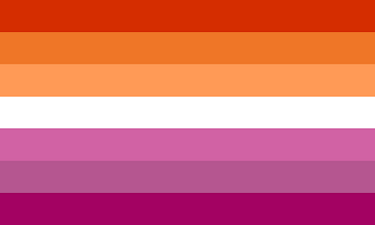
Lesbian is an orientation that describes someone with a non-heterosexual attraction to women, or women-aligned/feminine people in general.
The lesbian pride flag has had a few designs throughout the years, but the community lesbian flag, sometimes called the sunset lesbian flag, by Emily Gwen (SadLesbianDisaster on Tumblr, TheEmilyGwen on Twitter and Instagram) has been the most popular in recent times.
Color wise, it is a combination of the previously popular lipstick lesbian flag and the butch lesbian flag, and specifically put the butch stripes on the top, "to subvert the idea that femininity should come first". The red-orange stripe stands for gender non-conformity, the orange independence, light orange community, white unique relationships to womanhood, light pink serenity and peace, medium pink love and sex, and dark pink femininity.
Gay
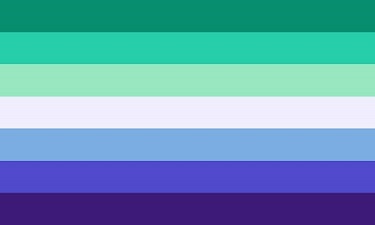
Gay is an orientation that describes someone with a non-heterosexual attraction to men, or men-aligned/masculine people in general. Gay is a term that can also be used by the LGBT community as a whole to describe being non-heterosexual, but the gay flag is exlusively used for gay people attracted to men.
For decades, the rainbow flag was used as the pride flag for gay people, but with it also being a flag that encompasses the community as a whole, the flag here was designed in 2021 by GayFlagBlog on Tumblr. The dark green stripe represents community, the light green healing, teal joy, white gender nonconforming, nonbinary, and trans men, light blue pure love, indigo fortitude, and purple diversity.
The dark green through teal colors also represent nature, as gay love is often seen as unnatural, and the historic symbolism of green carnations as a way of denoting if a man was gay. The flag avoided using a lot of blue, as blue being a stereotypical boy color got an earlier flag proposal to be seen as a lazy lesbian flag recolor. The light blue that leads into purple represents the diversity of gay men, from the stereotypical to the atypical.
Bisexual

Bisexual/biromantic is an orientation that describes someone with attraction towards two or more genders. Historically, it has meant attraction ot men and women, but in modern times, it can be any combination of attractions and may not include one or either binary gender.
The flag was designed by a team of activists in 1998, lead by Michael Page. Its color scheme was based on an existing symbol for bisexual people called the biangles, a pair of upside down triangles, one pink, one blue, and purple where they overlap, designed by Liz Nania. The pink stripe represents homosexuality, the blue heterosexuality, and the thin purple stripe in the middle bisexuality, the intersection of homosexuality and heterosexuality.
Transgender
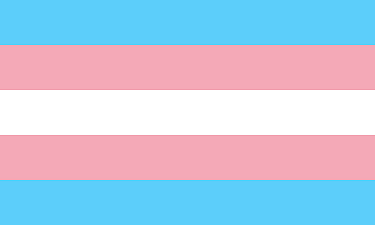
Transgender, often shorted to trans, is a term that refers to a gender that does not align with their perceived gender based on their birth sex. While it is typically an adjective to refer to binary trans people (trans men and trans women) it is also considered an umbrella term that encompasses nonbinary people.
The flag was designed in 1999 by Monica Helms and debuted in a 2000 Phoenix Pride parade. The flag is purposely horizontally symmetrical so it can never be flown upside down, and as symbolism for trans people "finding correctness in our own lives". The pink and blue stripes, being stereotypically gendered, represent men and women, and the white represents those who are transitioning, as well as nonbinary and intersex people.
Queer/Questioning
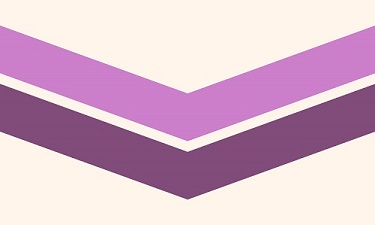
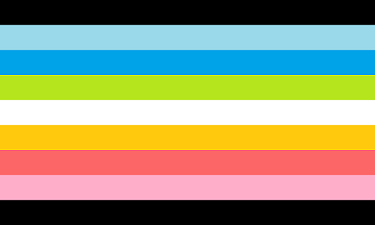
Queer is an umbrella term to describe someone who is not cisgender, straight, or both. Someone who calls themself queer might do so to refer to their identity as a whole, or as a term to describe themself when no other identity fits them. It can also be used as an alternative to referring to the LGBTQIA community.
The purple chevron flag was designed by Bizexuals on Tumblr in 2016. It uses purples because of the colors historical association with the LGBTQIA community, and the chevron as a deviation from standard straight lines. The off-white color for the background is used due to white being a combination of all colors of the rainbow.
The multi-color flag was designed by PastelMemer on DeviantArt. The pink and blue stripes represent same gender attraction, the orange and green nonbinary genders, and the black and white stripes aspec and agender people.
It should be noted queer was a prevalent slur in the late 1900s, and though it is still used in a derogatory manner to this day, the LGBTQIA community has largely reclaimed it. HOWEVER, if someone does not wish to be referred to as queer, do not call them queer.
Questioning, in the context of the LGBTQIA acronym, is someone who is exploring their gender identity or orientation. The rainbow flag and queer flags are often also used by questioning people.
Intersex
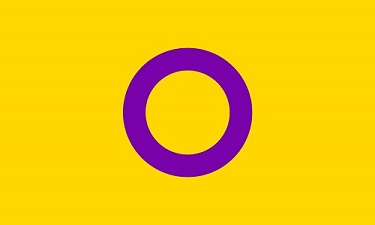
Intersex is an umbrella term for people whose biology does not entirely fit into a binary male or female sex. An intersex person may have variations in hormones, chromosomes, and primary or secondary sex characteristics.
The flag was designed by Morgan Carpenter of Intersex Human Rights Australia in 2013. Though the colors are given no meaning, the purple circle represents wholeness and completeness, and purple and yellow had long been associated with intersex communities and activism.
A-Spec
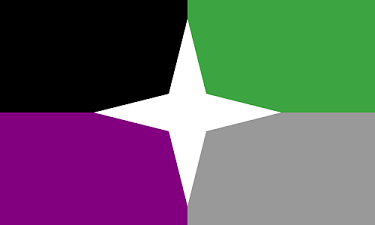
A-spec, or aspec, is short for the a-spectrum, which encompasses both the aromantic and asexual spectrum of identities. To be a-spec means to lack either romantic or sexual attraction to some degree, whether it be completely (asexual or aromantic) or partially (demi).
The flag was made by The-Moon-Is-Aroace on Tumblr in 2019. The green, representing aromantic spectrum, and the purple, representing the asexual spectrum, are on opposite corners of the four panel pane, emphasizing that they are individual and unique spectra and identities. The black represents aroace people, the gray graysexual and grayromantic people, and the compass rose in the center representing how everyone experiences attraction in different ways, including not at all. You can learn about specififc a-spec identities on the A-spec page.
